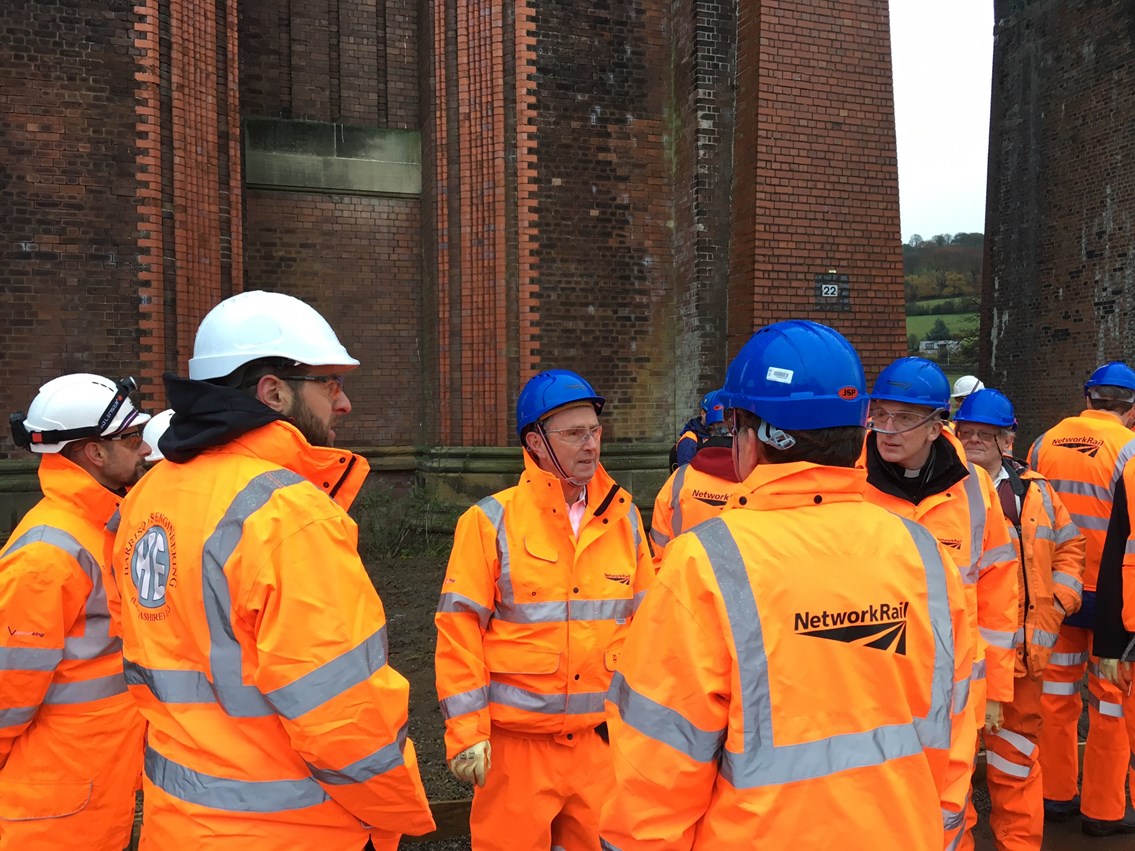Tuesday 22 Nov 2016
Rail investment to protect iconic Lancashire viaduct and reduce local flood risk
- Region & Route:
- | North West & Central
An iconic railway viaduct which carries vital passenger and freight services through Lancashire is being strengthened thanks to a £1.6m investment by Network Rail.
The essential work, part of the organisation’s Railway Upgrade Plan, will keep the historic Whalley Viaduct in use for decades to come and, thanks to an ingenious water storage system being installed, will also reduce the impact that water which drains from the structure has on the surrounding area.
Whalley was affected by severe flooding in Christmas 2015 and Network Rail is playing its part in the ongoing recovery effort by installing an extensive water storage system along the bottom of the viaduct. To help reduce nearby flooding, 16 catch pits and a control flow chamber have been dug out and 400 metres of pipes laid at ground level.
The system will hold back excess water collected from the railway and prevent it from being discharged into the River Calder when water levels are high. Once river levels have receded, the surface water is then slowly released into the watercourse.
Network Rail is also using a local business to help strengthen the structure’s walls and preserve the viaduct. Materials from Harrisons Engineering will be used during the project, including 2,800 steel brackets and 16,800 anchors. The company experienced the impact of flooding last year when its warehouse flooded.
Network Rail’s orange army will also be able to work more safely on top of the viaduct thanks to 1.4km of new handrails being fitted along the track to support them during maintenance work.
Last Friday, (18 November), MP for Ribble Valley, Nigel Evans, was joined by members of the Whalley & Billington Flood Action Group (W & B FLAG) and the local parish council to see first-hand the improvement work taking place and the unique water storage and release system.
Nigel Evans, MP for Ribble Valley said: “This is a win-win situation for Ribble Valley residents. It improves our rail connections whilst reducing the risk of flooding in the surrounding area. This will all occur without any disruption to the trains. Flooding is certainly an issue which is on the minds of residents; we are approaching the anniversary of last year’s floods and any initiative that decreases the probability of it happening again is a welcome sight.”
Andrew Ronnan, director of W & B FLAG said: "We are delighted to see the inclusion of latest high-tech water attenuation slow the flow equipment in this innovative scheme for a famous, listed status, Victorian structure that is a vital part of our country's rail transport network for both passenger and freight services. The civil and structural engineering project will in its own way, contribute to improved flood resilience for the Longworth Road area in Billington which suffered badly on Boxing Day last year.
“We confirm our support for Network Rail's own initiative.. It is an excellent example of the necessary multi-agency, holistic approach to improved flood resilience which of course takes time to achieve.
“Within 12 months of last year's devastating events though, our communities are already seeing substantial investment from both the public and private sectors at local, regional and national levels and in that respect, W & B FLAG is very grateful indeed."
Michael Lally, works delivery manager at Network Rail, said: “This £1.6 million improvement package at Whalley Viaduct will not only help reduce the risk of flooding in the village, but will also make sure this famous viaduct is safe to use for many years. Our Railway Upgrade Plan is providing a better, more reliable railway across Britain and in Whalley we are seeing even wider benefits by helping to reduce the flood risk in the local area.”
Liam Sumpter, northern area director for Northern, said: “Whalley Viaduct is an iconic railway structure and a key part of the infrastructure for Northern’s network. The work at the viaduct coincides with our own ongoing commitment – and substantial investment – to transform stations and services for our customers – meaning those who use the railway in Lancashire will see significant improvements during the coming months and years.”
The improvement work at Whalley Viaduct that started in October, will last approximately five months and will not cause any disruption to freight and passenger services.
Contact information
Passengers / community members
Network Rail national helpline
03457 11 41 41
Latest travel advice
Please visit National Rail Enquiries
Journalists
Network Rail press office - Jon Crampton
Media Relations Manager
Network Rail
0330 854 0100
07713 301440
jon.crampton@networkrail.co.uk
About Network Rail
We own, operate and develop Britain's railway infrastructure; that's 20,000 miles of track, 30,000 bridges, tunnels and viaducts and the thousands of signals, level crossings and stations. We run 20 of the UK's largest stations while all the others, over 2,500, are run by the country's train operating companies.
Usually, there are almost five million journeys made in the UK and over 600 freight trains run on the network. People depend on Britain's railway for their daily commute, to visit friends and loved ones and to get them home safe every day. Our role is to deliver a safe and reliable railway, so we carefully manage and deliver thousands of projects every year that form part of the multi-billion pound Railway Upgrade Plan, to grow and expand the nation's railway network to respond to the tremendous growth and demand the railway has experienced - a doubling of passenger journeys over the past 20 years.
Follow us on Twitter: @networkrail
Visit our online newsroom: www.networkrailmediacentre.co.uk

